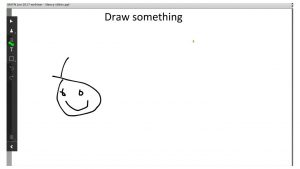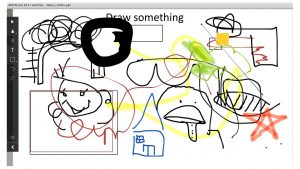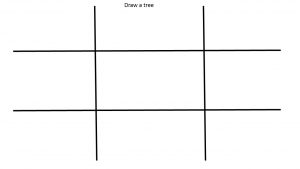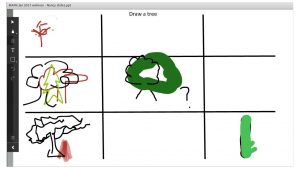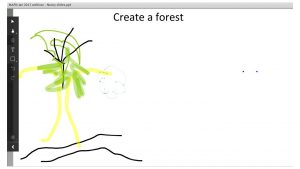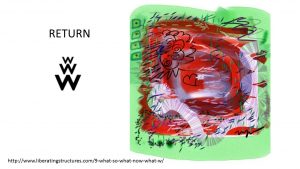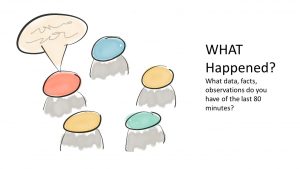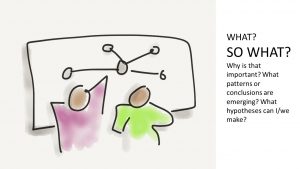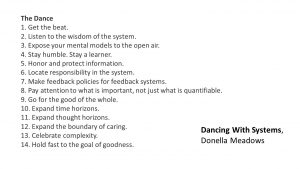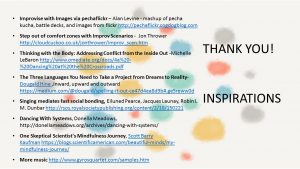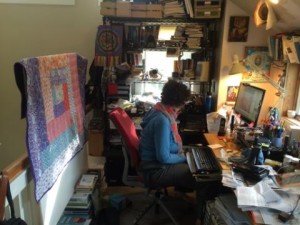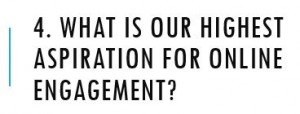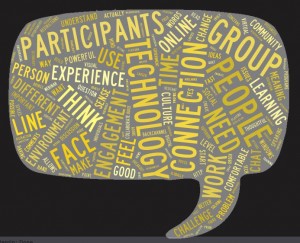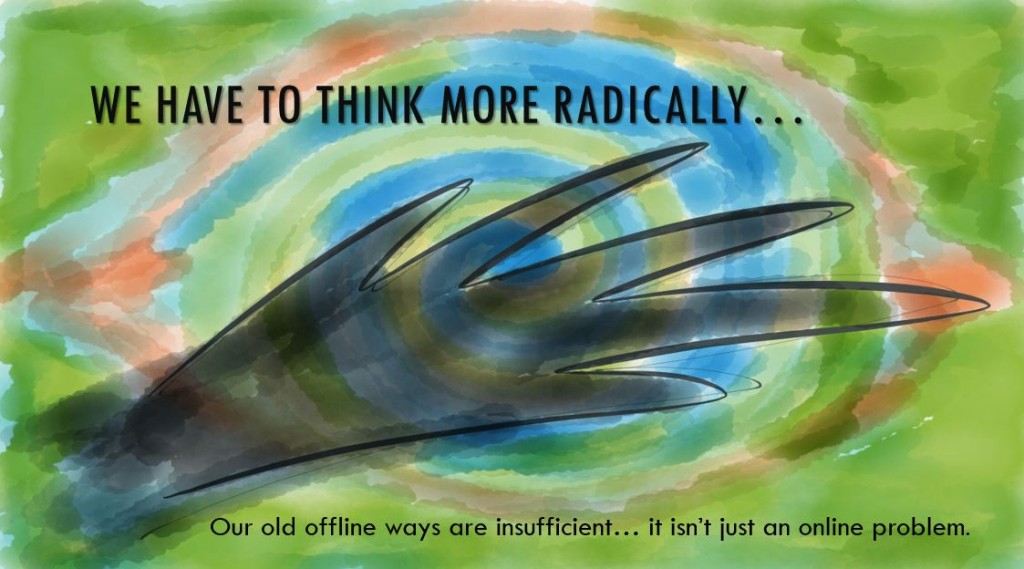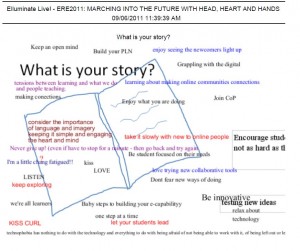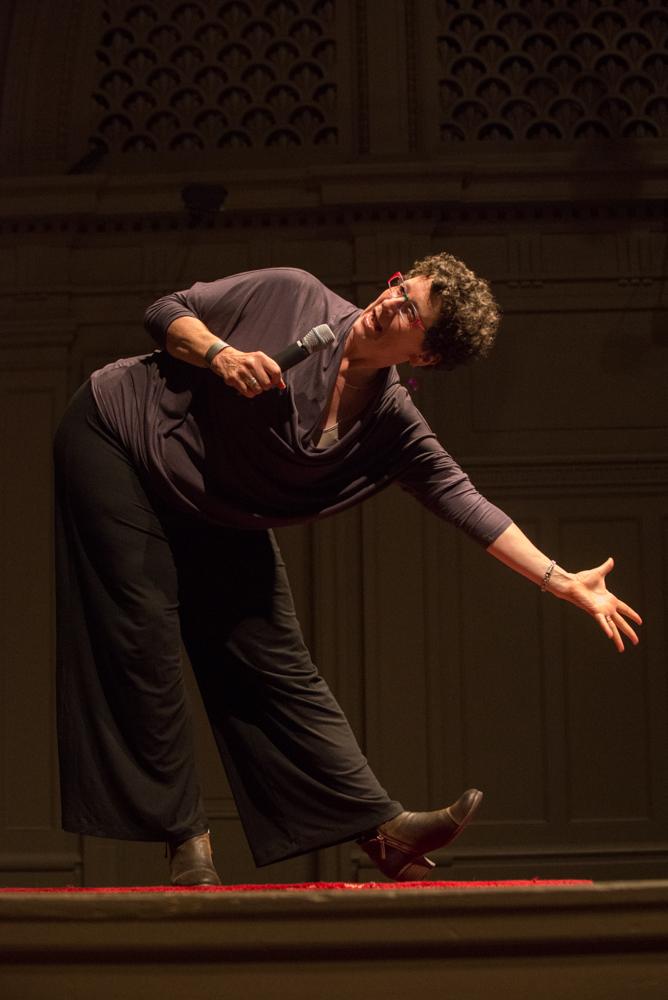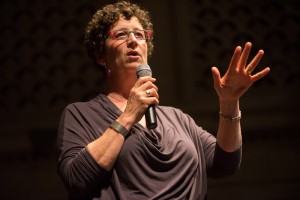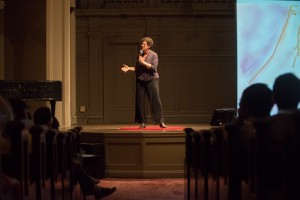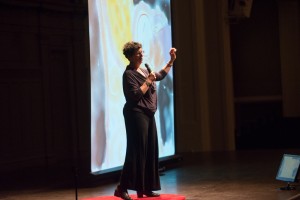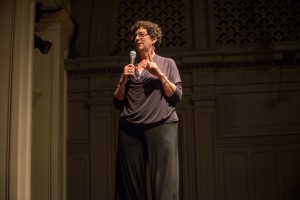 Warning: Long post suitable for process geeks and lovers of detail. The rest of you might want to skip to the bottom and download the annotated slides PDF!
Warning: Long post suitable for process geeks and lovers of detail. The rest of you might want to skip to the bottom and download the annotated slides PDF!
For the last few years I’ve enjoyed presenting a 90 minute synchronous session for the Mid Atlantic Facilitators Network, or MAFN. The hosting team is top notch, more organized and supportive than any other I’ve experienced, so it is easy to say yes when they invite me back. (This is worth a blog post of its own!)
Each year I use the opportunity to push my own borders. One year I introduced Liberating Structures (2014). Another year Any Lenzo, Nancy Settle-Murphy and I co-led a session about technology and facilitation (2015). I think there was something in 2016, but alas, memory fails!
This January I said yes again and decided to really push the boundaries of experiential co-learning in a synchronous online environment and play with what happens when we switch up sensory modalities. I positioned this ENTIRELY as an experiment, not a talk given by someone who is certain about something. That alone is an unusual twist. People expect experts. I arrive as a practitioner, and I love claiming this identity.
The title was Fingerpainting Online: Experiments in Synchronous Multimodality. The experiments I proposed included adding music, creating physical objects as interaction prompts, physical movement, taste/smell, vocalization and creation/destruction/recreation. I used the first modality of music by introducing a piece of music – a fugue – and riffing off the structure of fugues. That was probably taking my metaphoric imagination a bit too far, but it was fun. At the bottom of the post you can see pictures of the slides as well as an annotated PDF of the deck which include my notes and some of the anonymized feedback that happened in the group chat.
 Prior to the session, participants were emailed a list of preparations which included downloading and making a small paper foldable animal of their choice, having a snack near by, and printing out a note taking template I drew for them.
Prior to the session, participants were emailed a list of preparations which included downloading and making a small paper foldable animal of their choice, having a snack near by, and printing out a note taking template I drew for them.
Listen
The first modality was aural. Before I started even talking, we put on a clip of contemporary classical music. My camera was on so they saw my face as I listened, but I did not talk for a good 120 seconds. An eternity online. During this time I showed three slides, one a brief prompt asking people to think of the 90 minutes together as a piece of music, a quote from Donella Meadows on “getting the beat” of a system, and a definition of a fugue.
I want to explicitly share the Meadows’ quote here as it has value on its own. This idea that we observe, before we disturb. A great process tip!
Get the beat.
Before you disturb the system in any way, watch how it behaves. If it’s a piece of music or a whitewater rapid or a fluctuation in a commodity price, study its beat. If it’s a social system, watch it work. Learn its history. Ask people who’ve been around a long time to tell you what has happened. If possible, find or make a time graph of actual data from the system. Peoples’ memories are not always reliable when it comes to timing.
Donella Meadows
 When I finally talked, I offered the invitation into this experiment, confessing I had experiences as a practitioner, but no definitive expertise around the experiment. We then talked about the music. Some of the points I raised included:
When I finally talked, I offered the invitation into this experiment, confessing I had experiences as a practitioner, but no definitive expertise around the experiment. We then talked about the music. Some of the points I raised included:
- How we carry stress in our bodies, and how that influences group process as facilitators and participants. Music can begin to release some of that stress (or, in moments of uncertainty, create more.)
- Icebreakers were originally about creating somatic awareness, listening and connection. How does music break ice?
- Adults react to music based on their experience with that music. Our memory of a particular kind of music will influence the effect. Children tend to just jump into it and be with it. Dance, sing, listen.
- In my practice, I often use music that reflects context, domain, desired energy level. If I’m working overseas, I use a mix with local music – a subtle honoring of local context.
- I am often mixing things up, selecting music and language that is familiar enough, but has some unfamiliarity. This bit of dissonance serves to break entrained thinking patterns, and causes us to sit up and pay attention differently.
In the chat room, the comments resonated with some of these observations.
- It did not resonate with me
- I was curious. Wondering where this was going.
- I felt relaxed.
- It helped focus and ground me to the session
- curious
- Relaxed; soothing; all working together
- engages my right brain, which helps me access creativity (when we start discussing something)
- Calm, not thinking : )
- I was not concerned about where this was going. (thinking)
- relaxing and getting ready
- Felt lighter. Was thinking “this is different”
- Actually thinking about past experience of a client very liner which was uncomfortable with anything different.
- helps slow down the runaway train thinking…
- I think there’s a question in this for us as facilitators re. our role: are we sage on stage? are we simply facilitating their energy, so they own the process?
- Nancy White: Yes yes yes… hold that thought . When you change modalities, you change how people notice and pay attention. I’m going to take you on a sensory adventure. Music as conviviality and sociality. Music in complement to visual practices.
We were off and running. In the spirit of the three parts of a fugue, exposition, development and return, we did a bit more exposition and I reviewed the visual note taking template. The central part of the invitation was to treat this experience with curiosity, withholding swift judgement for each modality and then reflection. I warned them some of the parts of the experiment would be down-right weird, and some would be limited by the limits of the technology itself, and I was NOT aiming for some sort of perfect experience. It was EXPERIMENT!
Touch
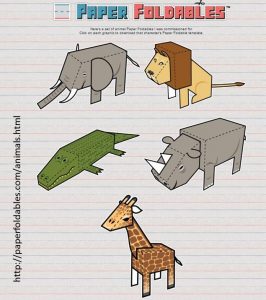 The next modality was the physicality of touch. Each person had picked, downloaded and built a small foldable animal. The animal they picked determined which chat breakout room they would go to and reflect on a prompt about the artifact they created. There were the elephants, the lions, alligators, rhinos and giraffes.
The next modality was the physicality of touch. Each person had picked, downloaded and built a small foldable animal. The animal they picked determined which chat breakout room they would go to and reflect on a prompt about the artifact they created. There were the elephants, the lions, alligators, rhinos and giraffes.
I asked them to download, print and build an animal based on something I learned years ago from Lisa Kimball. She was my first guide in online conferencing, back in the almost entirely asynchronous, discussion board days. When she hosted an event, she would send out a packet of printed materials (shocking!) which included something to print out, construct and keep by your computer. The agenda was printed on the different faces of the object we assembled. When we were online, one of the prompts was to hold the object when reading other people’s text comments. The kinesthetic experience in the conference, where we were all disembodied, help us feel a connection.
It was a great set up in Adobe Connect because while people chatted in their respective chatrooms, they could see all of the rooms and look “across” the experience. All the Rhinos are holding the same object, working on the same thing. Then we debriefed. Right off the bat one participant noted it was a “metaphoric opportunity” that helped us become present in a different way through the mere act of touching something. I smiled. Here are a few of the chat observations (beyond the riffing of animal jokes!):
- A tremendous amount of diversity of thought!
- Could be in multiple breakouts at the same time — and see what was happening in all of them at the same time.
- OK to not follow the rules – that in itself is a great intervention, encouraging people to speak up, and to take some ownership. (I told them they did not have to follow the rules I offered!)
- Metaphoric opportunity for application to real issues
- My lion just bit me!!
- Creating connection – all the rhinos, all the giraffes – I think that’s brilliant in a D&I context – we connect with other people around shared whatever; it creates an affinity that I might not feel for you because I don’t know you.
- Diversity and Inclusion
- Seem likes the object needs to be relevant to the to the group work at least as much as ice breakers
Move
Our conversation was moving us from the fugue’s exposition to development. We wrapped this section up by me asking them to take their hands off the keyboard, hold their animals, then imagine the other people in the group who had selected the same animal. A shared, somatic experience. And we moved right into the main somatic experience of moving. I invited people to stand up, move about for a few minutes. To release the tension in their hands, arms, neck and shoulders. To breathe. (See Linda Stone’s work on email apnea!)
Chat Notes after standing up and moving:
- I seemed to have greater energy . I was able to be more focused
- It’s fun to freak people out sometimes! : ) (reflecting on the fact that people in the office wondered what this person was doing!)
- I move more as I work
- relaxed me a bit
- it just occurred to me.. we should do this whole thing using xbox!! I’d love to see snapshots of people’s moves : )
- True! VR is the future and coming soon!
Think about the movement towards standing desks? (3+ participants said they had one, one didn’t know what a stand up desk was). How many walk with their phone during phone calls? We are learning that we are killing ourselves prematurely by sitting too much. There is a stream of work around “walking meetings” and redesigned work environments.
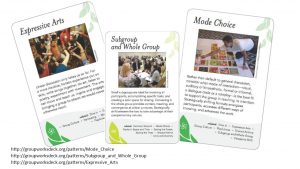 But what do we know about the value of movement in group process? We then explored the connection between moving, attention and how body position can impact attention and prevent more computer based multitasking. Stretch breaks.
But what do we know about the value of movement in group process? We then explored the connection between moving, attention and how body position can impact attention and prevent more computer based multitasking. Stretch breaks.
Dancing is a metaphor used in our work, just like music (“Its like Jazz!”) Movement and kinesthetic experience has long been incorporated into K-12 pedagogy. The link between math and balance board activities, the association of certain sports activities with areas of studies such as music and math, and the emerging consensus of the value of recess, particularly the physical play aspects, are visible and most of us are aware of them.
If you do a general analysis of group processes, looking at their underlying patterns, there are strong movement components. Large/Small/Large group alternation. “Stand up” meetings. Visual practitioners talk about the power of people getting up to a wall and making a mark (expressive arts) . The body, my friends, is powerful… Trios in walking tasks improve the quality of thinking and conversation.But we don’t find a lot of results with a Google search about physical aspects of online group facilitation. Building the kinesthetic experience into F2F is fairly common (mode choice), but not very often online. The most frequent thing you hear is to take physical breaks in online events every 40 minutes.
What might technologies like virtual reality help us do? How can our use of metaphors of movement (like dancing) stimulate the somatic memory. Donella Meadows talked about “dancing with systems.” There are ways of doing strategic planning that are about building resilience, flow and action versus a static plan. We need to build kinesthetic metaphors into our vocabulary and moving methods into our process. I move tables out of the room for more physicality (tables are for eating!), use the human spectrogram to tease out positions and avoid people getting trapped next to the two people they sat down between at the start. What does this look like online?
Different technologies influence our design. The invitation to engage in these things is important – the language we use. “This is too childish… we are adults.” If we have a clear purpose, the activity has to have a direct link to purpose. Talking about facilitation ideas in the abstract is less powerful, because their use towards purpose is what matters. The connection to the purpose: that is the integrity of the design.
Here are some of the ideas the group shared in the chat room: :
- Instead of having people sitting at breakout tables, have the groups gather around chart paper on the walls around the room
- I have people stand for exercises all the time . My purpose is to get them focused on the task and get their energy up
- Love the idea of walking breakout groups
- I have conference centers give us breakout rooms without tables and chairs. Only flipcharts
- If folks have cell phones, you can use the Adobe app, etc.
- How about hololens? An augmented reality headset. Like a next gen Google Glass
- when working from home, I walk around with my laptop
- Who says they all have that capability?How to get around the fact that people will sign in with diff technology that prohibits
- We breakout participants in groups at the end of a day’s session and ask them to produce a skit of their summary of key takeaways from the day. I am always surprised at how much adults love to produce and act! …we can geek out 🙂
- Love the language change suggestion!
- there’s a fun platform, MURAL, that allows you to do fun things on the computer that you would do in person – like creating and posting sticky notes with ideas. https://mural.co/
- A group of children is almost always more creative than a group of adults. So being “childish” may mean more creative.
Taste/Smell
It was about half way through the 90 minutes when we moved on to taste and smell. Snack time! We’ve heard the line: “Wake up and smell the coffee.” or “That is a tasty idea.” smell and taste metaphors are rich and common. They are one of my favorites because as a chocoholic, I often invoke it in many ways. I shared a picture using chocolate as a metaphor for coming together via a chocolate mandala at a retreat. Here was a bit of my rap:
Can you smell the chocolate? Does it remind you of something beyond the act of eating chocolate? Smell memories are some of the most powerful. Smell and taste are powerful parts of the limbic system. Associated with memory and feeling. They can trigger something almost Pavolovian.
“Because the olfactory bulb is part of the brain’s limbic system, an area so closely associated with memory and feeling it’s sometimes called the “emotional brain,” smell can call up memories and powerful responses almost instantaneously. “ (HowStuffWorks) When I smell “Love’s Baby Soft” perfume, my year as an exchange student in Brazil as a high school student rises up in all its detail, when otherwise I simply remember the stories I retold the most after my return. Rice cakes make me think of my pregnancies.
I invited you to bring something yummy to eat or drink. Take a sip or a bite right now, if anything is left. Pay attention to your body. What is happening?
While they were munching, I mentioned the work of a client at the CITA program who have introduced good nutrition before family court hearings. and how this simple act of providing protein is shifting court experiences and outcomes. Yes, our bodies are in this with our minds.
Immediately someone asked about the relevance of an experiment like this – the relevance to the purpose and the relevance of the group. Sometimes I step a bit away from purpose and look at creating or holding the space or conditions for working on a purpose. Punctuation – not the main meal, but things that help the main meal go well. But it can’t divert or detract from purpose. Our role is not entertainment – it has to be purposeful. But food has strong social connotations and it evokes memories. So how can we use this in online facilitation?
Chat Notes:
- Dark chocolate over coconut – the taste and smell is heaven!
- Wondering about the realistic application of this during an actual on-line session with people that use diff tech to participate and have diff ability and comfort level with any specific tech. Examples of your use of this ??
- Nancy: This is exactly my question, I don’t know the answer! 🙂 But I want to hear ideas!
- Does Adobe allow all of us to connect our cameras and audios for 30seconds?
- I like what you set up… inviting everyone to bring food / drink and even to eat/drink at the same time. And then… ask to share and go to impact or application??
- What are you eating? You can eat and type, but hard to eat and talk at the same time.
- coffee and almonds, here in Philly
- that was my point 😉 sharing everyone’s eating and drinking 🙂
- @ZZ, we can turn cameras on, but one person at a time. Anyone want to go on video for a bit?
- a smell that holds memory for you? and the feeling accompanying it/ and …?
- we have had ‘celebratory’ online meetings with colleagues around the world — the meeting was to celebrate the group’s work and get feedback on the process,
- Cranky if we aren’t experiencing good nutrition
- The same issue with nutrition happens with people with dementia or cognitive impairments
- I certainly agree that food is good for in person meetings, but it is interesting that I don’t want to be watching people eat on-line. Interesting. Is it just because it is different? Or am I impatient because I see it as taking up time?
- brain & thinking impact from chronic stress… ACES study.
- Appreciate the question and exploration of ideas for how to do this. At the end of the day does it not need to be relevantly useful for the group’s work?
- @YY agreed. But I’m finding myself enjoying seeing the coffee drinking.
- I’m with XX – don’t want to watch people eat 😉 adverse childhood experiences…
Sing/Vocalize
Next was the experiment that, in a previous setting, was the most challenging for people: shared vocalization in the form of singing. Now I know that when we open up multiple mics there will be a sound mess. Things won’t synch up, so I warned everyone in advance. Then we sang Happy Birthday together.
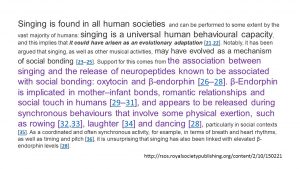 My friend Steve Crandall mentioned a while back some research about the role of singing and social bonding. (Two here and here.) This got me thinking about singing together. I did a little experiment last year at the Sketching in Practice conference in Vancouver, BC with groups using different modalities F2F and the group that had to sing to communicate was, well, not happy. They rebelled. Singing is not a shared public practice, it seems. 😉 We need to figure out how to USE it!
My friend Steve Crandall mentioned a while back some research about the role of singing and social bonding. (Two here and here.) This got me thinking about singing together. I did a little experiment last year at the Sketching in Practice conference in Vancouver, BC with groups using different modalities F2F and the group that had to sing to communicate was, well, not happy. They rebelled. Singing is not a shared public practice, it seems. 😉 We need to figure out how to USE it!
If you look at the development of shared communication, singing has played role. But we have often excluded in business as “not appropriate.” They create moments of discomfort, regardless of online or offline. Can we use these moments productively? Can we access the value of shared vocalization more deeply?
I’m not suggesting singing Kumbaya and holding hands, but thinking about the value of shared vocalization, in neurostimulation. As we work in a complex world with different people and contexts, shouldn’t we be calling about these things as part of our process? Shouldn’t we be asking these questions? Maybe just playing music alone is not enough, but need something purpose driven around shared vocalization.
“We show that although singers and non-singers felt equally connected by timepoint 3, singers experienced much faster bonding: singers demonstrated a significantly greater increase in closeness at timepoint 1, but the more gradual increase shown by non-singers caught up over time. This represents the first evidence for an ‘ice-breaker effect’ of singing in promoting fast cohesion between unfamiliar individuals, which bypasses the need for personal knowledge of group members gained through prolonged interaction. We argue that singing may have evolved to quickly bond large human groups of relative strangers, potentially through encouraging willingness to coordinate by enhancing positive affect.” http://rsos.royalsocietypublishing.org/content/2/10/150221
The online technology is not friendly to us today, but we should be asking questions about how we can improve the experience. Maybe virtual reality will help us.
Create/Destroy/Recreate
 And with that, we moved on to “create/destry/re-create” which is an experiment I’ve run many times in online meetings. This is the “finger painting online” bit – actually mouse-painting for most people, working on a shared white board and using images instead of words. I’ve written about this before, so I’ll move right into the debrief, as this post has grown to gargantuan proportions. Oops!
And with that, we moved on to “create/destry/re-create” which is an experiment I’ve run many times in online meetings. This is the “finger painting online” bit – actually mouse-painting for most people, working on a shared white board and using images instead of words. I’ve written about this before, so I’ll move right into the debrief, as this post has grown to gargantuan proportions. Oops!
The debrief of the open drawing of the first round:
- started to look like jackson pollack by the end!
- it got messy!
- incites curiosity
- looks like Guernica
- Depends what we are trying to do.
- confused
- LOL
- For this kind of exercise it felt right
- overwriting each other’s pictures could get in the way of purpose, or not!
- I greatly improved other peoples drawings…
- connection, another way to hi
- the idea of an exercise of building off others’ work if interesting
- This is a self selected group of people willing to experiment
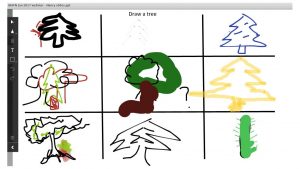 The second round where a grid and specific instructions were provided:
The second round where a grid and specific instructions were provided:
- started to look like jackson pollack by the end!
- it got messy!
- incites curiosity
- looks like Guernica
- Depends what we are trying to do.
- confused
- LOL
- For this kind of exercise it felt right
- overwriting each other’s pictures could get in the way of purpose, or not!
- I greatly improved other peoples drawings…
- connection, another way to hi
- the idea of an exercise of building off others’ work if interesting
- This is a self selected group of people willing to experiment
 And the third round where we opened things back up to a more emergent creative practice:
And the third round where we opened things back up to a more emergent creative practice:
- This is an awesome exercise… here’s what it looks like in a room as part of a world cafe: http://lizardbrainsolutions.com/zwixnxzvcauu2d39y9ijr7kbumu9y1
- Lol. Love the gump!
- Ah, I see Forrest Gump
- ha ha….ha
- shared purpose
- more like the first time
- tower of babel tasking
- felt more like intentional collaboration I looked for places to add, elaborate
- jointly effort because we have a theme
- it felt like we were all contributing to an agreed end product
- It seems the drawings appeared at the same time.
- more detail possible but still does not resemble tree
- surprise, but shared purpose — yielded unexpected results you could build on
- some people dominating?
- a cactus would have been nice.
- After creating several trees, I looked for open spaces. Trying to work together.
- its difficult to control the stroke sometimes – inadvertently infringed on people’s space
- would love to have the drawing exercise with music in the background!
Look at the progression: We had no constraints, then constraints, and then between the two we find the space to work together. We built awareness of intentionality and purpose, of our own acts and the acts of our colleagues. Fisher Qua has been doing a group drawing on large paper that starts with individual drawings on the perimeter of the paper and then work collaboratively towards the center. In a space of unfamiliarity, we act differently into the experience.
World Café table clothes where large white paper is set on each table with a range of colored pens for spontaneous doodling and drawing are a very good example of this F2F. So too with drawing on whiteboards — we have a subtle negotiation of visual space and an easy place to play in the online space.
The Return
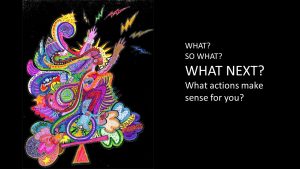 Our time was coming to an end. We reached the “return” stage of our metaphorical fugue. We started easy with aural and ended with easy with visual. We explored how to pay attention together and work together. Individually. Collectively. At a distance and yet really together. We concluded with a “What? So What? Now What?” debrief which you can read in the PDF below.
Our time was coming to an end. We reached the “return” stage of our metaphorical fugue. We started easy with aural and ended with easy with visual. We explored how to pay attention together and work together. Individually. Collectively. At a distance and yet really together. We concluded with a “What? So What? Now What?” debrief which you can read in the PDF below.
For me, the insights were these:
- We need to actively understand and experiment with including more modalities and approaches in our online work if we truly want to learn and work and play together online.
- Switching helps us out of our thinking ruts and into new, productive spaces for engagement.
- Discomfort is ok. Let’s use it productively.
- We have a lot more work to do!
MAFN FingerP ainting Together Online Jan 2017 Annotated


